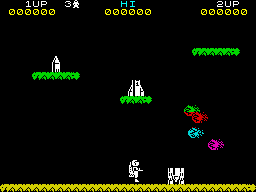Jetpac
| Jet Pac | |
|---|---|
 Jet Pac ZX Spectrum cover | |
| Developer(s) | Tim and Chris Stamper |
| Publisher(s) | Ultimate Play the Game |
| Platform(s) | ZX Spectrum BBC Micro Commodore VIC-20 |
| Release date(s) | ZX Spectrum, VIC-20 1983[1] BBC Micro 1984[2] |
| Genre(s) | Shooter game |
| Mode(s) | Single player |
| Distribution | Cassette (Spectrum, BBC, VIC-20) ROM cartridge (Spectrum) |
Jet Pac is a ZX Spectrum, VIC-20 and BBC Micro video game developed and released by Ultimate Play The Game in 1983. The game is the first in the Jetman series, and was the company's very first release. The game was written by Chris Stamper with graphics by Tim Stamper. Jetpac was one of the very few Spectrum games also available in ROM format for use with the Interface 2, allowing "instantaneous" loading of the game when the normal method of cassette loading could take several minutes.
Gameplay
 Three rocket sections need to be assembled before Jetman can leave this planet. |
In the game, Jetman has to first assemble his rocket (which comes in kit form), and then fill it with fuel before taking off to the next planet (where the procedure is broadly repeated). Along the way Jetman has to defend himself from the planet's aliens, and for bonus points collect valuable resources which occasionally fall from the sky.
After the first level, the rocket stays assembled and just requires refuelling. However, every five levels, the rocket is changed and the replacement has to be built before it can be fuelled for take off. Each new model has a new design with a higher number written on it, although the gameplay is unchanged.
The single game screen is a horizontal wrap around and consists of three platforms on which Jetman can stand.
The enemies change each level (cycling back to the first after eight levels) and each alien has a different pattern of movement which means they can be dealt with in a different manner. For instance, the "dart" enemy tends to hover in a vertical column on the left-hand side of the screen until it fires across the screen whereas, the "flying saucer" aliens will follow Jetman around and so require a different strategy.
Reception
Crash magazine praised the graphics and presentation, which were "of the highest standard",[3] adding that it was "difficult to find any real faults".[4] ZX Computing said it was "a very well put together piece of software. An excellent game."[5] The game was number one in the first Spectrum sales chart published by C+VG.[6]
The game was voted the 14th best Spectrum game of all time by Your Sinclair.[7]
| Reception | ||||||||||||||||||||||||||||||||||||||||||||||||||||||||||||||
|---|---|---|---|---|---|---|---|---|---|---|---|---|---|---|---|---|---|---|---|---|---|---|---|---|---|---|---|---|---|---|---|---|---|---|---|---|---|---|---|---|---|---|---|---|---|---|---|---|---|---|---|---|---|---|---|---|---|---|---|---|---|---|
| ||||||||||||||||||||||||||||||||||||||||||||||||||||||||||||||
| ||||||||||||||||||||||||||||||||||||||||||||||||||||||||||||||
Sequels, ports and remakes
Two sequels were released: Lunar Jetman (1983) and Solar Jetman: Hunt for the Golden Warpship (1990). The latter, however, was not released on the ZX Spectrum due to disappointing sales of the original NES version, although a version for the Commodore 64 was finished but never released.
In 1999, Jetpac was introduced to a new generation as Rareware included it in Donkey Kong 64. It could be unlocked to play in Cranky Kong's lab, and if players successfully got 5000 points, they would be rewarded the game's Rareware Coin. After taking pictures of 6 Banana Fairies, the player would be able to play it and Donkey Kong any time they wish by going to the Mystery Menu of the main menu.[10] An enhanced remake of Jetpac, entitled Jetpac Refuelled, was released to Xbox Live Arcade on March 28, 2007.[11]
References
- ↑ "Jetpac". Personal Computer Games (2): 7. November 1983.
- ↑ "Jetpac review, BBC Micro version". Computer and Video Games (38): 36. December 1984.
- ↑ http://www.worldofspectrum.org/showmag.cgi?mag=Crash/Issue03/Pages/Crash0300064.jpg
- ↑ http://www.worldofspectrum.org/showmag.cgi?mag=Crash/Issue04/Pages/Crash0400057.jpg
- ↑ http://www.worldofspectrum.org/showmag.cgi?mag=ZXComputing/Issue8308/Pages/ZXComputing830800107.jpg
- ↑ http://www.worldofspectrum.org/showmag.cgi?mag=C+VG/Issue023/Pages/CVG02300037.jpg
- ↑ http://www.ysrnry.co.uk/articles/50bestspeccygames94.htm
- ↑ http://www.worldofspectrum.org/showmag.cgi?mag=C+VG/Issue021/Pages/CVG02100136.jpg
- ↑ http://www.worldofspectrum.org/showmag.cgi?mag=HomeComputingWeekly/Issue016/Pages/HomeComputingWeekly01600015.jpg
- ↑ "Donkey Kong 64". GameSpot. CNET. Retrieved 2006-05-30.
- ↑ "Jetpac Refuelled". Xbox.com. Microsoft. Archived from the original on 2008-02-22. Retrieved 2008-02-25.
External links
- Jetpac at Ultimate Wurlde
- Jetpac at World of Spectrum
- Jetpac at MobyGames
| Preceded by |
UK number-one Spectrum game September–December 1983 |
Succeeded by Lunar Jetman |
| |||||||||||||||||||||||